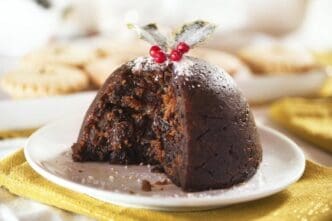Imagine greeting a dessert that’s none other than a boiled mass of suet and dried fruits soaked in alcohol and set aflame. For an American living in Britain during the 1990s, this was the unexpected encounter with Christmas pudding, a treat with a rich, tangled history linked to the British Empire. While it might not top everyone’s list of holiday favorites, its roots reach far and wide, with ingredients sourced from countries once under British rule.
Christmas pudding has evolved from a mix of medieval British dishes. It began as ‘plum pottage,’ a porridge-like dish with meats, dried fruits, and spices—ingredients that were easily preserved until winter festivities. Back then, ‘plum’ referred to various dried fruits like raisins and currants, not just plums. This hearty mix transformed over time, combining with ‘figgy pudding,’ another staple of the era, to create the familiar plum pudding by the 18th century.
As British trade expanded, so did access to exotic ingredients once seen as luxury items. French brandy, Mediterranean raisins, Caribbean citrus, and cane sugar—all products of the vast British Empire—became more common. Affordable sugar, made possible through the labor of enslaved Africans, particularly boosted plum pudding’s reputation, turning it into a British delicacy. It even starred in satirical illustrations, highlighting its cultural significance in Britain.
With the Victorian era came a reimagined version of plum pudding, aptly renamed ‘Christmas pudding.’ Charles Dickens’ ‘A Christmas Carol’ immortalized it as a cornerstone of the festive meal, describing a flaming pudding adorned with holly. Queen Victoria’s chef later published a recipe that made it attainable for the British middle class, featuring candied fruits, spices, and copious raisins. Even those on tighter budgets found ways to enjoy the dessert, swapping pricier items like brandy for ale or using simpler recipes.
The spread of Christmas pudding coincided with the British Empire’s reach, as settlers sought to replicate British customs abroad. This meant the pudding made its way to places like Australia, where miners celebrated with it alongside their other meals. Its alcoholic content granted it a lengthy shelf life, which proved useful for sending it to soldiers stationed far from home.
In the early 20th century, the Christmas pudding was hailed as the ‘Empire Pudding,’ promoted by the British Women’s Patriotic League. This campaign emphasized using empire-sourced ingredients such as Australian fruits, Ceylonese cinnamon, and Jamaican rum, replacing French brandy. The 1926 Empire Day in London showcased this, with representatives mixing ingredients in a ceremonial bowl, symbolizing unity within the empire.
Even after the end of the British Empire, the allure of Christmas pudding did not wane. Passengers can still find it in London’s bustling airports during the holiday season, despite its dense texture causing occasional delays at security checks. In places like Canada and India, the tradition endures, though variations like ‘pudim’ have emerged, demonstrating its adaptability.
Christmas pudding, with its roots entwined in history and empire, continues to be a beloved holiday tradition. Its journey from a medieval dish to a modern Christmas staple reflects the cultural exchanges that have shaped this culinary classic. Whether enjoyed in its traditional form or with contemporary twists, it remains a symbol of festive joy, bringing warmth and history to tables around the world.
Source: Yahoo







